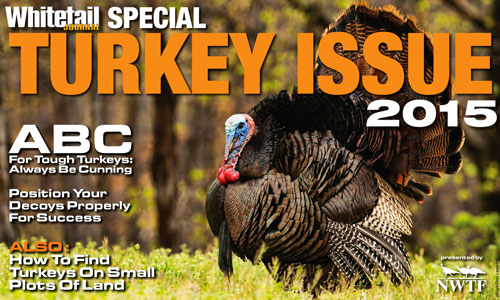Featured in Whitetail Journal's Special Digital Turkey Issue
Every spring, some folks grab a choke tube labeled “turkey” or “super full” and hit the woods. Without realizing it, they’ve already handicapped their hunt.
“For a turkey hunter, the choice of a choke is quite important,” said Clark Bush of allaboutshooting.com.
Bush believes the process of choosing a choke should begin long before the season. Hunters should consider the shot type (lead or tungsten-based), shot size (No. 4, 5, 6 or 7) and the differences in shotshell construction between manufacturers.
“The shot size combined with the wad type should help guide your choice,” he said. “Lead and tungsten-based shot in sizes 6 and 7 with conventional wads will flow equally well through (12-gauge) chokes with exit diameters between .640 and .675, with or without wad-stoppers” he said. “Chokes that are non-ported and without wad-stoppers will produce better patterns with Flitecontrol wad shells. And although No. 4 and 5 shot might retain more energy, it’s difficult to produce dense patterns with them.”
Terrain and hunting conditions add to the choices. If you typically experience close-quarters shots at gobblers — say 25 yards or less — any good lead shot with a tested choke will work. If you usually face longer, open-field opportunities, tungsten-based shot is a wiser choice.
Of course, you must experiment with several choke-and-load combinations to find the one that patterns best in your gun. One hundred pellets within a 10-inch circle is still the standard for a deadly turkey pattern. If your choke-and-load combination doesn’t produce that type of pattern, experiment with other combinations or back off your yardage a bit. Usually, modern shotshells and quality after-market chokes will perform far better than that to 40-plus yards.
“Range time will let you know your capabilities with a given choke and shell,” Bush said.
Your shotgun’s barrel also figures into the equation. Turkey hunters favor shorter-barreled guns, but those might not produce patterns as dense as those provided by longer barrels. As such, those guns might require a tighter choke.
“It’s best not to get hung up on numbers if you’re using a shorter barrel,” he said. “You want to look for dense patterns with no large (2 inches or more) gaps or holes in it. Smaller shot — No. 6 or 7 — helps to fill in the gaps and is quite deadly at ethical ranges.”
Many hunters also worry about choke performance in “overbored” barrels compared to a standard 12-gauge bore (.729).
“Constriction — the difference in the inside bore diameter of the barrel and the exit diameter of the choke — can make a difference, but it’s really more about the internal geometry of the choke than just constriction alone,” he said. “With overbored barrels, 100-plus points of constriction is not too much if the choke is properly designed. A barrel with an inside diameter of .775 responds very well to chokes with a .670 exit diameter, as does a .742 inside-diameter-bore barrel to chokes with .640 exit diameters.”
Long-term maintenance is also important. Bush said hunters should break in their choke tubes much like they would a new rifle or pistol barrel. Also, they should learn to “deep clean” the choke and must store it properly during the off-season. Information on the break-in and deep-cleaning procedures can be found at www.allaboutshooting.com.
This season, don’t ignore that seemingly unimportant tube at the end of your barrel. It determines how many pellets will deliver sure-kill downrange energy to a gobbler this spring. The more you’ve tested and fine-tuned your choke-and-load combination, the deadlier your gun will be.






